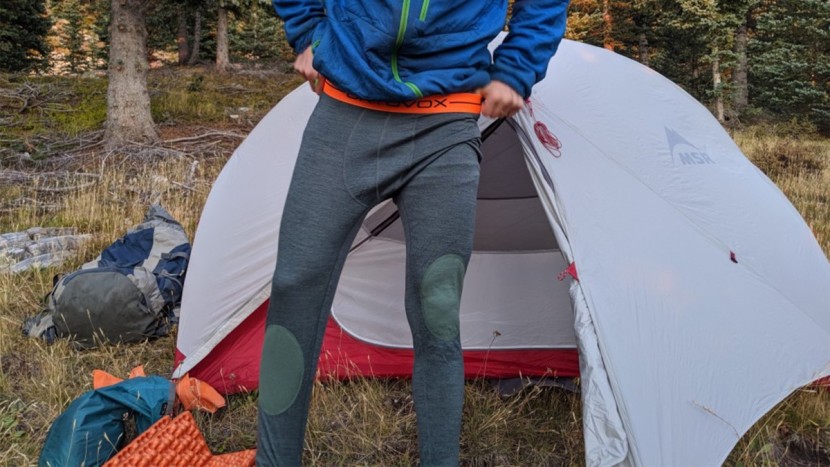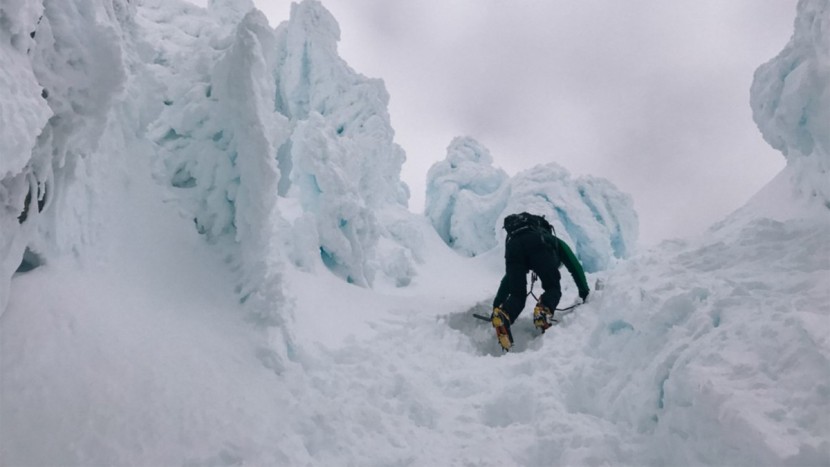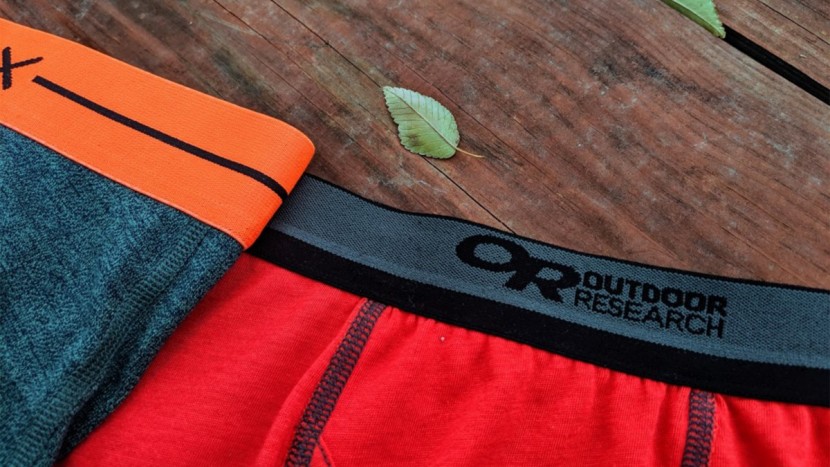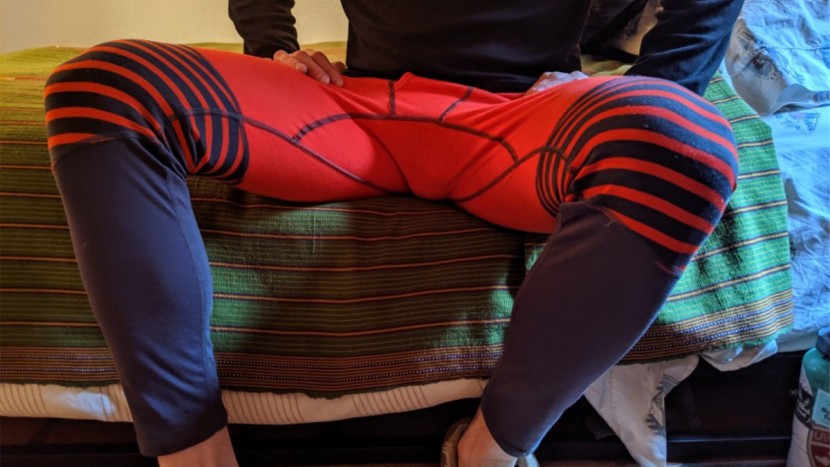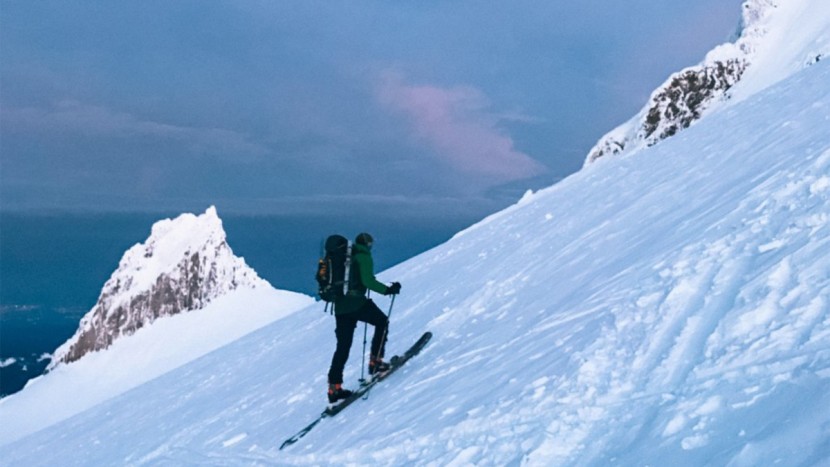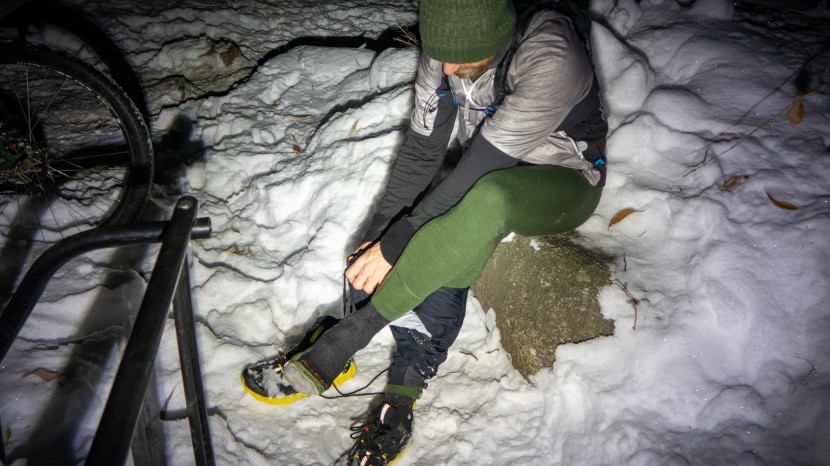By combining field experiences — like skiing down dormant volcanoes, sleeping through frosty desert nights, and running on snowy mountain trails — with specific lab testing designed to objectively analyze vital metrics, we work to create a comprehensive review process to rank these products side-by-side. This process allows us to note how well each pair of bottoms perform through a wide range of activities and environments and then either support or contradict those findings with in-house testing. Below we break down how we test for each of the four metrics that make up the basis of our long underwear review.
Warmth
We test for this factor just as any logical person would — we wear them in cold conditions, both alone and as part of a layered system, and we make notes on how comfortable they keep us in varying levels of cold. We don these bottoms as a stand-alone layer while shoveling the driveway or out on early-morning runs in the chill of fall. We layered up to stand at the summit of Mt. Hood with sub-freezing winds, for sleeping while backpacking through the high-alpine environments of New Mexico, and for gathering around bonfires with friends on chilly nights.
Breathability
In the field, we tested breathability by pushing ourselves to work up a sweat in a myriad of environments and temperature ranges — from pre-dawn skinning in sub-freezing temperatures to trail-running in the hills outside of Salt Lake and Santa Fe. In the lab, we conducted a more controlled breathability trial to support our field testing. In a temperature-controlled environment, we go through a highly aerobic, body-weight workout. Testing each pair of bottoms side-by-side, we go through a quick routine of push-ups, pull-ups, burpees, jump squats, and mountain climbers. We note how much sweat we worked up to judge general breathability, how well that particular layer did in terms of wicking away sweat, and then timing how long it takes for our skin to dry. Finally, we assess each layer's air permeability using a simple peak flower meter. All of this helps us assess how well each pair will dry off on the body while pushing through vigorous activity.
Comfort and Fit
This metric is tested by wearing these bottoms while we're out playing and making lots of notes on how the features fit, how comfortable each pair feels, and how all of this works together to support garment performance. A few examples of things that we don't want to see in a pair of long underwear are: the waistband stretching out over time, tightness through the calves or cuffs, awkward crotch sag, and uncomfortably bunching when layering. Through careful observation and close scrutiny of details, we analyze each bottom to see how it compares relative to each other pair. Some factors that contribute to our assessment of comfort are: how enjoyable they are wearing next-to-skin; the comfort and fit of the waistband; their ability to layer smoothly; and any particular observations that result in the bottoms feeling uncomfortable or awkward. While 100% Merino wool layers are often the plushest, we try to remain objective in our evaluation of this inherently subjective metrid. We've noticed that in recent years, 100% recycled polyester is giving the all-natural fibers a run for their money when it comes to next-to-skin comfort.
Fit is a more detailed investigation into how the garment is designed and how that translates into how it wears on the body. Factors such as seam patterns and articulation, the length of legs and tightness of the cuffs, the cut of the seat and crotch, ease of fly access, how well the bottoms stretch and move with you, and any additional features or thoughtful touches that may contribute to a remarkable fit. Through careful analysis in the lab of their design and many notes taken during hours of field testing, we hope to paint a pretty sophisticated picture of how each pair of bottoms may fit.
Durability
Outside of living in these bottoms and dragging them along on our climbing, skiing, running, rafting, and hiking adventures, to objectively test durability, we also conduct a controlled test in the lab that measures the durability of the face fabric against abrasion. We grind the knees of the fabric a set amount of times across an 8-inch distance of gritty granite to see how the fabric fairs (think washing board technique.) This may seem overly aggressive when compared to likely real-world applications, but this specific test gives us a very clear idea of how each bottom holds up to abrasion. While some layers only develop a bit of surface wear, others develop holes immediately. We also send them through a relentless amount of machine wash and dry cycles — a great indicator of realistic product life.
Drying Speed
In addition to our on-body assessments of drying speed, we fully saturate each pair of bottoms and then hang them to record air-dry times. We note how long it takes for the face fabric to dry and how long it takes for the entire garment to dry all the way through. By comparing these bottoms side-by-side, we can gather some more objective information about how efficiently individual fabrics purge moisture. It is important to know that saturated hang-dry times do not exactly reflect the garment's ability to wick away sweat, the most important factor in terms of keeping you dry during activity. Some fabric types — especially Merino wool — typically have slow hang dry times when the fibers are soaked all the way through but do an excellent job of staying dry on your body. But it does give us an objective way to test how quickly a face fabric evaporates moisture or how quickly a layer may dry out if you're washing and laying it flat to dry on a rock during a backpacking trip.
Layering Ability
For all the bottoms we have, we'll take them on a tour of our own mid and outer layers, including our running tights, winter cycling lycra, mountaineering pants, hiking knickers, and even our favorite pair of worn-in jeans. How well do they work as a system with these other layers? Any standouts or problems? Are there some base layers that work with a specific type of outer layer? Can the features that are advertised in these long underwear work once underneath something the original manufacturer wouldn't expect?

